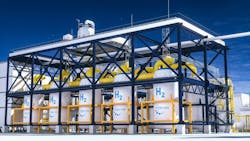One of the hottest topics in sustainability today is using hydrogen to store power. However, what makes it even more attractive to net-zero supporters is using the excess capacity of renewable energy sources like solar and wind to electrolyze water into green hydrogen, which can be consumed, emissions-free at a later time.
“We focus on sustainability and particularly decarbonization. A major strategy of decarbonization is using green hydrogen to reduce greenhouse gas (GHG) emissions. Because green hydrogen uses renewable energy like solar and wind, and has the potential to decarbonize many industries, it’s been a focus of ours for some time,” says Justin Ryan, director of technology and energy transition at Avid Solutions Inc., a system integrator and certified member of the Control System Integrators Association. “Green hydrogen can be used when alternative energy sources aren’t feasible, when electrification and batteries aren’t viable, or where carbon-intensive hydrogen is used in manufacturing.”
Ryan reports that Avid was the system integrator for the largest proton exchange membrane (PEM) electrolyzer facility in the U.S., which started production in January 2024. The Plug plant is located in Woodbine, Ga., and produces up to 15-tons per day of liquid hydrogen. Plug produces hydrogen that’s used by its fleet of fuel cells or sold to customers.
“Fuel cells require hydrogen to produce power. As a result, Plug has been steadily acquiring companies and technologies to produce green hydrogen themselves. Leveraging their PEM electrolyzer technology, Plug built its first industrial-scale production facility. Its electrolyzer and overall, balance-of-plant (BOP) controls were designed and deployed by Avid. These controls were based on Rockwell Automation’s PlantPAx process automation system. This includes the controls of all BOP applications, including pure water for electrolysis, plant air, cooling systems, purge gas, power distribution and rectifier integration, and storage and shipping terminals. In addition to the BOP controls, we integrated unit controls for the main process consisting of electrolysis, gas drying, pure-gas filtering and liquification,” explains Ryan. “For example, liquefaction uses a cryogenic process to compress and cool hydrogen for storage and shipment at -423 °F based on Chart Industries technology. All of these assets were designed to be integrated and work together.”
The facility also has FM-listed, fire-and-gas system (FGS) protection and a safety instrumented systems (SIS) provided by Avid. These act as independent layers of protection. The FGS was designed with detector placement based on a provided gas dispersion analysis. The provided detectors monitor for leaks, flame and gas concentration above a safe, lower explosive limit (LEL).
Liquid, green hydrogen from the Woodbine plant is shipped via cryogenic storage trucks to clients with large warehouses, such as Amazon, Wal-Mart and Home Depot, which use it in their hydrogen-powered forklifts. These retailers can refill a forklift with hydrogen in about 5 minutes, compared to needing 15 hours to recharge a battery-powered forklift. “The U.S. Dept. of Energy (DoE) estimates that demand for hydrogen in the U.S. will reach 10 million metric tons per year (MMT/yr) by 2030 and 50 MMT/yr by 2050,” says Ryan. “To achieve this goal, tax breaks are available for switching to renewable energy sources or using them in infrastructure projects. To demonstrate some of this capability, Caterpillar and Microsoft use hydrogen fuel cells for data center backup power as a replacement for a fossil-fuel solution.”
Match know-how with application
To accelerate decarbonization projects and technologies, Ryan recommends partnering with a trusted partner, who is focused and experienced in green hydrogen production. “We gained a ton of experience in green hydrogen production in the past few years. Working with our client and technology partners, there was a lot to learn from integrating these systems at this scale.” explains Ryan. “We developed fit-for-purpose applications with the company’s electrolyzer OEM group to help build its first green hydrogen plant with standardized repeatable solutions.”
Over the past 35-years, Avid specialized in pharmaceutical, chemical, nuclear, and oil and gas projects. Ryan explains that undertaking green-hydrogen projects meant adding more staff with the right experience to meet demand. “There’s simply not a lot of engineers with green-hydrogen experience,” adds Ryan. “This is why we had to investigate and learn more about hydrogen gas processing. From material-of-construction choices to instrument selection to operating philosophy, there any many nuances to consider.
“In addition to process operations and control knowledge gains, it’s critical for project developers to work with good partners, EPCs and technology providers to properly plan and scope projects. Avid works closely with partners like Endress+Hauser, SMA, ABB, Rockwell, S&B Engineering and aeSolutions to bring valuable experience to the table. Beyond having good partners, it’s also essential to study and participate in hydrogen-related organizations, such as the NFPA 2’s prescriptive standard for hydrogen and the Compressed Gas Association’s H5 requirements.”
This is part one of Control Global's July sustainability cover story. To read the other installments, click here.
About the Author
Sign up for our eNewsletters
Get the latest news and updates

Leaders relevant to this article:

